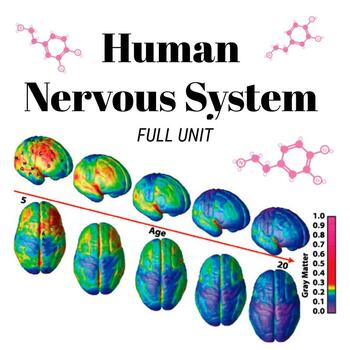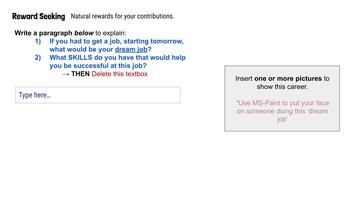Human Nervous System - Middle School Science FULL UNIT
- Google Drive™ folder

Products in this Bundle (4)
Description
Progression of Guiding Questions:
- How is our brain organized?
- How does our brain learn new skills?
- What is dopamine?
- What are the 'advantages' of being a teenager?
Progression of Learning Targets:
- I can analyze the structure and function of the human brain.
- I can investigate how our brain learns from our environment and changes based on age.
- I can investigate how brain cells communicate and cause "feelings".
- I can apply and connect what I have learned about the teenage brain's maturity to my personal life.
(Green Circle) Playlist
Students will identify the three primary brain regions (cerebrum, cerebellum, and the brainstem), learn about the structure and function of our right vs. left side of the brain, and define the function of each of the four lobes of the cerebrum. This playlist is designed to introduce students to the general structure of our brain and help them draw connections between the various brain regions and their associated functions. Later in this unit, students will learn about the manner in which our brain matures over time by analyzing the rate of maturity of each different brain region.
[Blue Square] Playlist
Students will learn how the brain is just one part of our human nervous system. They will record notes to learn how to identify the dendrite, myelin sheath, axon, axon terminal, and soma of a neuron. They will also learn how the brain goes through stages of pruning and stages of increasing the myelin as behaviors are repeated over time. This introduces students to how our brain adapts to our environment and allows us the ability to learn. They will apply their learning to make a simple model of how myelin creates pathways for learning in our brains. The focus of this playlist is on how our brain is able to learn! Therefore, there is an assessment included which asks students to answer a series of prompts to provide scientific reasoning about how our brain changes when we learn new stuff.
<Black DIamond> Playlist
Now that students have a grasp on the general structure and function of our brain and how it adapts to our environment and “learns” new skills they will investigate the role of neurotransmitters. To start, students will learn about how the brain regions mature over time just as the rest of our body does. They will identify the stereotypical behaviors of teenagers as a result of the brain regions that have not fully matured. Students will connect the prefrontal cortex to executive functioning and then define the various attributes which fall under the umbrella of ‘executive functioning’. They will also explore the limbic system by recording the various functions of its four regions (thalamus, hypothalamus, amygdala, and hippocampus). Next, they will learn about synapses so that they can understand where neurotransmitters come into play. The final task in this playlist is to summarize the properties and function of eight different neurotransmitters.
<>Double Black Diamond<> Playlist
To begin this playlist, students will record notes as they learn the evolutionary advantages to the teenage stage of brain development. Then, they will connect their takeaways about learning, brain maturation, and their teen brains to explore how they engage in risk taking, sensation seeking, social networking, reward seeking, and human connection in their lives. This is a great way to get to know students better and to help them understand that they are in a stage of development and their brains are currently growing, changing, and adapting.
As I transition into the final assessment which asks students to use scientific evidence to respond to the debate prompt, “Should Schools Ban Smartphones?”, I take time to focus on the neurotransmitter, dopamine. Once you begin the debate process, you will be able to emphasize the role of dopamine as students engage with the resources. Students will watch The Social Dilemma, read opinion/forum pieces published in the journal Nature (Feb 2020), and read scientific articles that explore social media, smart phones, and teen mental health. The final assessment will ask students to take a position on the prompt “Should Schools Ban Smartphones?” based on evidence that they collect from each resource.
This product contains assignments that lead students toward answering a guiding question via a Learning Target. Students accomplish this by completing digital assignments using Google Docs, Slides, and Forms. They will also use assignments to collect data and add notes into an interactive science notebook. (In my classroom all students have a composition notebook for this purpose). An “end of playlist” formative quiz is also included.
This product contains assignments that lead students toward answering a guiding question via a Learning Target. Students accomplish this by completing digital assignments using Google Docs, Slides, and Forms. They will also use assignments to collect data and add notes into an interactive science notebook. (In my classroom all students have a composition notebook for this purpose). An “end of playlist” formative quiz is also included in this bundle.
This resource includes ALL 4 parts of a series of tiered playlists that develop student's depth of knowledge as they complete assignments that progress through Bloom's taxonomic hierarchy. These playlists progress through the Ski Slope Model of Teaching. The four playlists are, in order; (Green Circle), [Blue Square], <Black Diamond>, and <>Double Black Diamond<> playlists. Each playlist builds upon the one prior and grows in complexity and depth.
This resource contains materials which address aspects of the following Next Generation Science Standards (NGSS): NGSS MS-LS1-1, NGSS MS-LS1-2, NGSS MS-LS1-3, NGSS MS-LS1-8
*These resources have been used in a real-life middle school science classroom with real-life students in Colorado!





